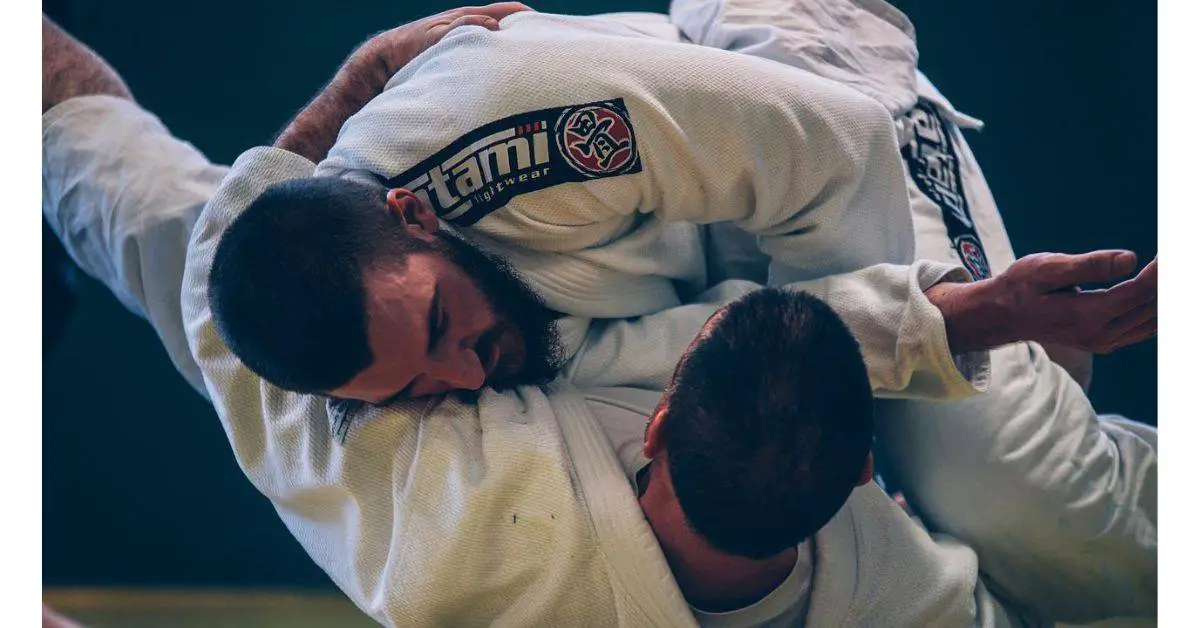The Loop choke is one of my personal favorites. I’m a big fan of it, not for the reason some of you might think: because it’s effective. But, while it’s an effective submission, it’s not why I’m a fan of it.
Instead, I’m a Loop choke fanatic; However, the reasoning behind it is that it will open your mind and allow you to get more creative. Understanding and learning this submission is critical because it’ll help you understand and better grasp the world of submissions in Brazilian Jiu-Jitsu.
Performing the Loop choke isn’t difficult. However, you can make various mistakes along the way. These mistakes will prevent you from advancing and having a solid basis for performing this choke flawlessly. Eventually, it’ll be the difference between losing and winning a BJJ fight.
This article aims to go over these mistakes one by one and fix them. That’s why I recommend you read the article in its entirety. Even a step such as starting in side control will benefit you since it’ll mention the extra ninja tips you must know to perform it flawlessly.
So, without further ado, let’s dive in.

How to perform the Loop choke
Performing the Loop choke isn’t tricky. So instead, I want to focus on my favorite variation in this profound breakthrough.
Again, I recommend reading each step thoroughly because most of the steps include a ninja tip on fixing the most common mistakes novice and even advanced grapplers make when performing this submission.
This variation will open your mind and require you to get as creative as possible. As such, don’t hesitate to learn and master it to ensure your grappling game stays up there.
You want to learn it even if you won’t use it in your real fights, although it can be effective in those situations. Instead, you want to learn this variation to ensure your mind is creative and able to grasp the world of submissions.
This variation is the Loop choke from side control using a Gi. It’s one of the most creative variations.
Without further introduction, let’s break it down.
Step #1 – Start in the side control position
The first step is to start in the side control position. To remind you, this variation will be the Loop choke from the side control position. And as you can imagine, this submission has more variations, such as from the mount, closed guard, and open guard.
So the first step of this variation is to start with the side control position. You want to go with the old-school one, as it’ll provide you with the most profound basis to continue the choke.
Now, you want to start by waiting for the opponent to push you. That’s the first ninja tip. After that, utilizing the opponent’s movements against himself will be best.
That’s why you want to wait for him to push you and try to evade your control. Once he does that, you want to go into step #2; this will give you more space to act and allow you to finish the Loop choke more often.
Attaining side control can be more difficult than some of you might think. My favorite way is passing the opponent’s guard and attaining this position. If you want to see the most effective guard passes in BJJ (so you can learn them), follow the link.
Step #2 – Circle your arm around his head
The second step will be to circle your arm around his head. Again, you want to pay extra attention when performing this step.
Once you circle your arm around the opponent’s head, he’ll start to feel the pressure rolling. Thus, you want to transition into the 3rd step as quickly as possible.
Although I’m breaking these steps down, you must understand that they flow together. So while it’ll be better to stick to one step at a time, you also want to minimize the time between each one unless you wait for the opponent’s reaction.
If you want to learn about yet another effective submission, follow the link to read about the Kimura and how to perform it flawlessly.
Step #3 – Grab his collar with the same hand
The 3rd step is to grab his collar with the same hand. Once you grab the collar, you want to go through the 4th step as early as possible.
Ensure you grip the collar with a 4-fingers grip. You don’t want to hold it too tightly or grip it with your entire hand. That will make matters more complicated in the future.
Once you grip the collar, you can move to the 4th step.
Step #4 – Wrap your other arm around his arm
Now that you have grabbed the opponent’s collar with 4 of your fingers, you want to keep on moving forward. The next step will be to wrap your other arm around his arm.
You want to go over and not under his arm. Doing so will allow you to tighten the choke when you’ll be applying pressure. I recommend watching the timestamp I set in the video below this paragraph to ensure you understand this step thoroughly.
Indeed, in this case, seeing it visually will complete your understanding of this step.
Step #5 – Move in the direction of his head
This step is a relatively simple one, so I’ll keep it short.
Once you have circled your first arm around his head, grabbed his collar, and wrapped your other arm over his arm and in the direction of his head, you want to change your direction toward his head.
Although it’s a simple step, you don’t want to forget it. It can be critical when you start to tighten the choke. The last thing you want is for the choke to be loose and the opponent to evade your offensive means.
This will leave you vulnerable. So, ensure to get this step right before going over the 6th step (the last one!)
Step #6 – Move your fingers upward
The next step will be to move your fingers upward. Again, you want the motion to be slower than most people do when performing it for the first time.
The fingers you want to move are your second-hand fingers. Your first hand should be gripping his collar, so you can’t move them.
The choke will be extra tight if you follow it thus far correctly. As a result, there’ll be a lot of pressure on the opponent’s neck even if you don’t move your fingers upward.
Thus, you must do this step slowly to ensure the opponent taps out in time and allows you to release your pressure before he goes unconscious. Therefore, you must pay extra attention to this step, specifically to this step.
It’ll be easy to notice the opponent tapping out. However, if you’re thinking about the steps and trying to make them flawless, your focus won’t be on the opponent but yourself. You want to change that when moving your fingers upward to ensure you release the pressure in time.
Step #7 – Apply pressure
Now, you want to keep applying pressure until the opponent taps out. Likely, your choke won’t be as tight as if you were performing it for the 100th time.
As a result, ensure to keep working on it until you build that muscle memory.
Nonetheless, you must keep moving your fingers upward and apply pressure until the opponent taps out.
And still, pay close attention to your opponent; is he breathing? Is he tapping out? Always make sure the opponent is conscious. These are questions you must ask yourself and look out for.
Step #8 – Wait for the tap
And the last step will be to wait for the tap. I always include this step in my breakthroughs because you must pay attention to it as much as you do to the technical ones.
Release ALL pressure once you feel the opponent taps.
Alright! You’re now a proud owner of the knowledge of this Loop choke variation from side control (with Gi.) You can now start practicing it. Ensure to follow each step and avoid making the mistakes I mention in my breakthrough. Good luck!
Variations of the Loop choke
This part of the article will cover 4 variations of the Loop choke. So if you’re interested in seeing more options and expanding your horizons, this is the best part of the article.
As you know me, I’m a big fan of learning everything that you possibly can. The more knowledge you have, the better you’ll be able to act in the world, especially in the world of martial arts.
Enough introduction; let’s dive in.
Variation #1 – Loop choke from guard (No-Gi)
The first variation we’ll discuss is the Loop choke from the guard position without a Gi.
This variation utilizes the same movements as the one I’ve broken down in this article. Here’s how it goes:
- Start in the guard position
- Wait for the opponent to push forward
- Circle your arm around his head (over)
- Wrap your other hand (similar to the Guillotine)
- Squeeze and apply pressure
- Wait for the tap
Variation #2 – Loop choke from side control
You want to start in the side control position and wait for the opponent to push you. The next step is to circle your arm around his head and wrap your other arm over his arm and around his head (in the other direction.) Now, you move your second-arm fingers forward and wait for the tap.
This is the variation I broke down earlier in this article. So, I won’t go into further details about it.
Variation #3 – Loop choke from closed-guard
The 3rd variation we’ll discuss is the Loop choke from the guard position (with Gi.) This one allows you to submit your opponent while in closed guard. Learning it can be more than valuable to the rest of your BJJ journey, as it’ll help you win more fights.
- Start in the closed-guard position
- Grip the opponent’s collar loosely
- Push the opponent toward you
- Circle his head with your arm (over)
- Insert your other arm through the space you created
- Squeeze by turning to the side
- Wait for the tap
The key with this one is to grab the opponent’s collar loosely, not tightly. Having a more firm grip might decrease the pressure you’ll put on the opponent in this case.
Variation #4 – Standing Loop choke
The standing Loop choke is the same as everything we’ve learned thus far. Now, I decided to mention it in this article because it’ll get your brain to start thinking about more ways you can apply this submission.
Really, your options are endless. You can perform most submissions from positions you never thought possible. So, let’s see how to perform this variation properly:
- Start standing up
- Grab the opponent’s collar
- Push him toward you
- Circle your arm around his head
- Turn and fall to the mat
- Grab his opposite arm
- Pull his arm
- Wait for the tap
Look at how creative BJJ coaches get with their teachings. You can learn this variation and use it in self-defense and BJJ fights. So, make sure to watch the video below to get a better grasp of this variation!
Should I use the Loop choke with Gi or No-Gi?
Although I presented variations with and without a Gi, there’s a clear winner between the two. Let’s see which is more effective in this case, the variations with Gi or No-Gi.
The Loop choke is more effective when it’s used against a Gi. The primary reason that’s the case is because of the grip. You will have a much more firm grip when you grip the opponent’s collar. As a result, you’ll have an easier time going through the steps than when you don’t have any grip.

It should come as no surprise that grip is critical in grappling, especially BJJ. You want to have as firm of a grip as possible on the opponent. That will allow you to control him.
And finally, if you don’t own a Gi and want to own one, I wrote an article on the best grappling Gi’s you should buy, so give it a read!
When should I use the Loop choke?
The Loop choke is best used when you’re either in closed/open guard or in side control. The mounted and the standing variations aren’t as effective. As a result, it’ll be best to stick to the side control and guard variations, as you will get the most taps using them.
Is the Loop choke effective?
The Loop choke is a highly effective BJJ submission. It allows you to apply extreme pressure levels while using the opponent’s Gi as your tool. This won’t only cause a lot of pressure but also surprise most opponents. And learning this submission will force you to think outside the box, making you a better grappler.
I recommend sticking with the variations I presented in this article, as they’re the most effective ones.
Final words
Well, this is the end of this article. But, I hope it’s a new beginning for you. In my own BJJ journey, I treat each technique as an entire world. So, I want to emphasize my appreciation for this submission, as it can be more than adequate.
What I love about the Loop choke is that it’s a creative submission. So many submissions today are straightforward and won’t give you many opportunities to think outside the box.
I’m confident that all grapplers and fighters can benefit from being more creative. Thus, I encourage you to practice this choke, even if you’re not positive you’ll use it in your journey.
While it’s an effective choke, I only ranked it 6/10 on the effectiveness scale. So, there are more effective techniques out there. Follow the link to learn about the most effective BJJ submissions from side control!
You’d also enjoy reading about these topics if you were interested in this article:

